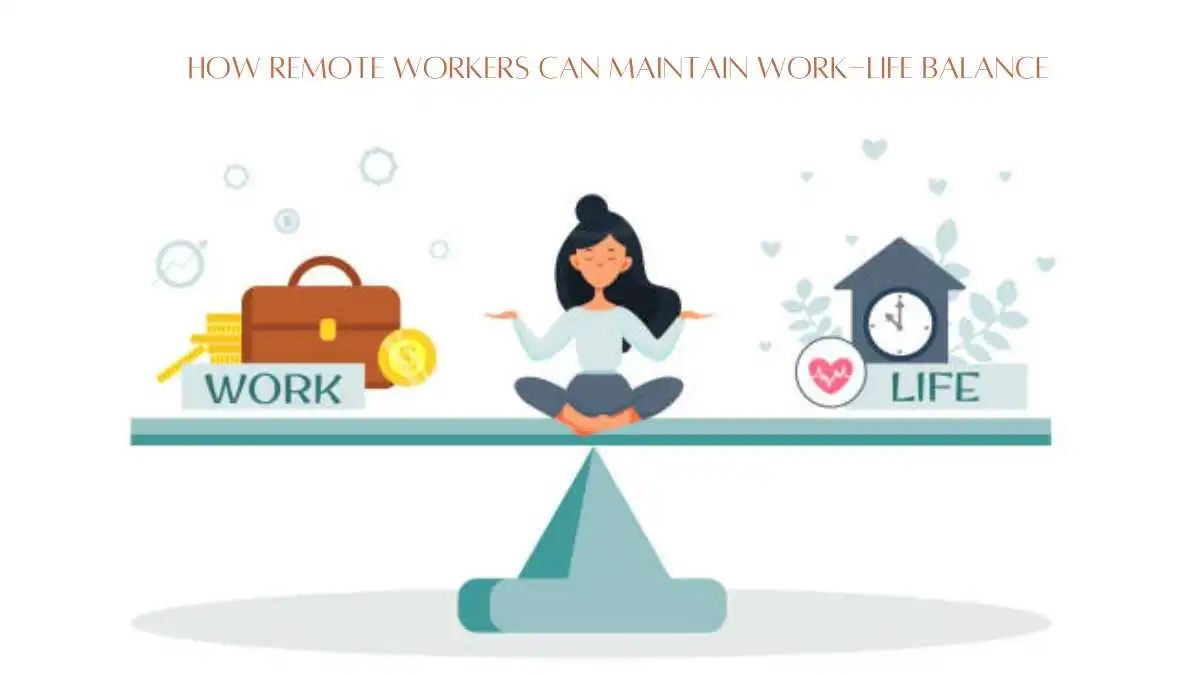GENERAL
How Remote Workers Can Maintain Work-Life Balance: A Comprehensive Guide

Remote work offers flexibility, freedom, and the opportunity to design a lifestyle that integrates work and personal life seamlessly. However, it also presents unique challenges, such as blurred boundaries, work creeping into personal time, and feelings of isolation. Without a structured approach, remote workers can quickly experience burnout and a decline in productivity and overall well-being.
This guide provides practical strategies for maintaining work-life balance while working remotely, ensuring you can enjoy the best of both worlds—professional success and personal fulfillment.
Table of Contents
1. Understanding Work-Life Balance in Remote Work
Work-life balance means managing professional responsibilities while making time for personal interests, health, and relationships. Unlike traditional office jobs where physical separation exists between work and home, remote workers must intentionally create that division to prevent work from dominating their lives.
Some key challenges of remote work include:
- Blurred Boundaries: Without a clear office setting, work can spill over into evenings and weekends.
- Overwork and Burnout: The pressure to always be “available” can lead to longer work hours.
- Distractions at Home: Household chores, family, and personal tasks can interfere with work.
- Isolation and Loneliness: The absence of in-person interactions can take a toll on mental health.
By recognizing these challenges, remote workers can take proactive steps to establish balan
2. Setting a Structured Routine
One of the most effective ways to maintain balance is to establish a well-defined routine. A structured schedule mimics the rhythm of an office job while preserving the flexibility of remote work.
Tips for Creating a Daily Routine:
- Start and End at Consistent Times: Define your work hours and stick to them to prevent work from creeping into personal time.
- Morning Rituals Matter: Engage in a morning routine—exercise, meditation, reading, or breakfast—to mentally prepare for work.
- Take Scheduled Breaks: Use techniques like the Pomodoro Technique (25 minutes of work followed by a 5-minute break) to enhance productivity.
- Log Off Completely: When work is done, shut down your laptop and resist checking emails or messages outside of work hours.
Having a structured routine helps train your mind to shift between work and personal life effectively.
3. Designating a Dedicated Workspace
Working from bed or the couch can make it difficult to separate work from relaxation. A dedicated workspace enhances focus, efficiency, and the psychological transition between work and home life.
Tips for Creating a Home Office:
- Choose a Quiet Area: A separate room or corner of your home should be designated for work.
- Invest in Ergonomics: A comfortable chair, desk, and proper lighting reduce physical strain and boost productivity.
- Limit Distractions: Keep your workspace tidy, away from household noise, and free of non-work-related items.
- Set Boundaries: Let family members or roommates know when you are working to minimize interruptions.
A dedicated workspace signals to your brain that it’s time to work when you sit there and time to relax when you leave.
4. Setting Boundaries Between Work and Personal Life
Boundaries are crucial for remote workers to ensure they don’t feel obligated to be “always on.”
Ways to Set Work-Life Boundaries:
- Establish “No Work” Zones: Keep your bedroom and living areas free of work-related activities.
- Use Separate Devices if Possible: Having a work laptop and a personal device prevents work from invading personal time.
- Communicate Your Availability: Set expectations with colleagues about when you are available for meetings and emails.
- Create an End-of-Day Ritual: Whether it’s shutting down your laptop, taking a walk, or listening to music, signal to yourself that the workday is over.
Boundaries help reinforce the division between work and personal life, reducing stress and preventing burnout.

5. Prioritizing Self-Care and Mental Well-being
Remote workers often neglect self-care due to increased workloads and fewer social interactions. Prioritizing physical and mental health is key to sustaining long-term productivity.
Strategies for Self-Care:
- Exercise Regularly: Whether it’s yoga, strength training, or a daily walk, movement helps reduce stress and improves energy levels.
- Eat Nutritious Meals: Avoid snacking all day and maintain a balanced diet for sustained focus.
- Get Enough Sleep: Maintain a consistent sleep schedule to support overall well-being.
- Take Mental Health Breaks: Short walks, meditation, or hobbies can rejuvenate your mind.
- Stay Hydrated: Drink plenty of water to prevent fatigue and maintain cognitive function.
Remote workers must be intentional about self-care to avoid burnout and maintain work-life balance.
6. Managing Time Effectively
Time management is essential to prevent work from consuming your personal life. Efficient time management leads to greater productivity, allowing for more free time.
Effective Time Management Strategies:
- Use a Planner or Digital Calendar: Schedule tasks, deadlines, and breaks.
- Prioritize Tasks: Follow the Eisenhower Matrix to distinguish urgent tasks from non-urgent ones.
- Batch Similar Tasks Together: Grouping emails, meetings, and creative work into blocks of time reduces task-switching fatigue.
- Avoid Multitasking: Focus on one task at a time to improve efficiency and reduce stress.
- Use Time-Tracking Apps: Tools like Toggl or RescueTime help monitor work hours and identify productivity patterns.
Mastering time management ensures that work does not take over your personal life.
7. Incorporating Social Interaction
Remote work can be isolating, making it essential to nurture social connections.
Ways to Stay Connected:
- Schedule Virtual Coffee Chats: Connect with colleagues or friends via Zoom or Google Meet.
- Join Online Communities: Engage in industry groups, remote work forums, or local meetups.
- Attend Networking Events: Participate in webinars, workshops, or coworking events.
- Maintain Personal Relationships: Make time for family and friends outside of work.
Building a social support network prevents loneliness and keeps you engaged with the world beyond work.
8. Using Technology to Support Work-Life Balance
Technology can be a double-edged sword—it can help with productivity, but it can also make it difficult to unplug. Using the right tools can help you maintain balance.
Best Tech Tools for Work-Life Balance:
- Project Management Tools: Trello, Asana, or Notion help keep work organized.
- Time Tracking Apps: Clockify and Toggl monitor work hours.
- Focus Tools: Freedom and Cold Turkey block distractions.
- Meditation and Wellness Apps: Headspace and Calm promote mindfulness.
- Virtual Coworking Spaces: Focusmate simulates an office environment for better concentration.
Using technology strategically can help remote workers stay productive without compromising their personal lives.
9. Taking Advantage of Remote Work Flexibility
One of the greatest benefits of remote work is flexibility. Utilize it wisely to enhance your overall quality of life.
How to Make the Most of Flexibility:
- Adjust Your Work Hours (if possible): Work during your peak productivity periods.
- Take Midday Breaks: Use lunch breaks for exercise, hobbies, or relaxation.
- Travel While Working (if permitted): Experience different environments while maintaining your job.
- Spend More Time with Family: Remote work allows for better integration of personal life into your schedule.
By leveraging flexibility, remote workers can create a fulfilling and well-balanced lifestyle.
10. Regularly Evaluating and Adjusting Your Work-Life Balance
Maintaining work-life balance is an ongoing process that requires periodic evaluation.
Steps to Assess Your Balance:
- Check Your Work Hours: Are you working more than necessary?
- Evaluate Your Stress Levels: Are you feeling overwhelmed?
- Assess Your Personal Life: Are you spending enough time on relationships and hobbies?
- Make Adjustments as Needed: Modify your schedule, boundaries, or workload if needed.
Regular check-ins ensure that remote work remains a sustainable and enjoyable experience.
Bonus: R&D Tax Credit for Remote Workers
If you’re a remote worker in an innovative field like software development, engineering, or product design, you may qualify for the R&D Tax Credit. This tax incentive rewards businesses, freelancers, and contractors who contribute to technological advancements by offsetting tax liabilities or payroll taxes for eligible expenses. It’s particularly beneficial for small businesses and startups investing in research, process improvements, or new technologies. By leveraging the R&D tax credit, remote workers can reduce tax burdens and reinvest in their work, making it a valuable tool for financial optimization. Consult a tax professional to determine your eligibility and maximize your savings.
Final Thoughts
Work-life balance is essential for remote workers to thrive both professionally and personally. By setting boundaries, managing time effectively, prioritizing self-care, and leveraging technology, you can create a fulfilling work-from-home lifestyle.
Remote work should empower you, not exhaust you. By following these strategies, you can maintain a harmonious balance that supports both career success and personal happiness.
-

 GENERAL2 months ago
GENERAL2 months agoUncovering the World of кинокрадко: The Dark Side of Film Piracy
-

 GENERAL1 month ago
GENERAL1 month agoUnveiling the Art of преводсч: How Translators Bridge Language Barriers
-

 YOGA1 year ago
YOGA1 year ago4 Person Yoga Poses for Beginners
-

 GENERAL2 months ago
GENERAL2 months agoThe Journey of iamnobody89757: From Anonymous User to Internet Sensation


























